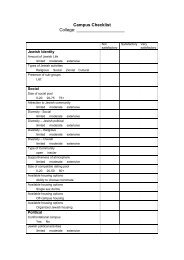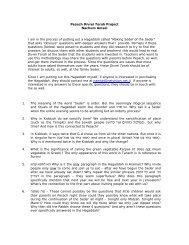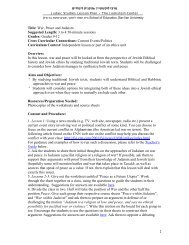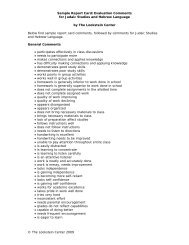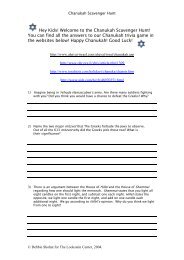FUNDAMENTAL CONCEPTS of the CLASSICAL HEBREW VERB
FUNDAMENTAL CONCEPTS of the CLASSICAL HEBREW VERB
FUNDAMENTAL CONCEPTS of the CLASSICAL HEBREW VERB
Create successful ePaper yourself
Turn your PDF publications into a flip-book with our unique Google optimized e-Paper software.
Chapter 10<br />
THE SUBJUNCTIVE (AND IMPERATIVE)<br />
Moods <strong>of</strong> <strong>the</strong> finite verb<br />
The subjunctive, which occurs very very frequently, is usually ignored in grammar books, or else treated in a<br />
very <strong>of</strong>f-handed manner, and never really explained properly, perhaps because it is so seldom understood.<br />
In different languages <strong>the</strong>re are different ‘moods’ which express different functions <strong>of</strong> <strong>the</strong> verb. Depending<br />
on <strong>the</strong> language, <strong>the</strong>se may include <strong>the</strong> imperative for commands; <strong>the</strong> optative for wishes and hopes; <strong>the</strong> jussive<br />
for commands for which <strong>the</strong> imperative is not used; <strong>the</strong> cohortative for self-encouragement; <strong>the</strong> subjunctive for<br />
subordinate clauses, and so on. Do not try to remember all <strong>the</strong>se, we will not use <strong>the</strong>m. All <strong>of</strong> <strong>the</strong>se are moods<br />
o<strong>the</strong>r than <strong>the</strong> indicative, which we have met and which is used for plain statements. Now in Hebrew, <strong>the</strong><br />
imperative is quite distinct. All <strong>the</strong> o<strong>the</strong>rs use <strong>the</strong> same form, and what we are concerned with is not giving<br />
fancy names like <strong>the</strong> above for <strong>the</strong> different functions and meanings, but one name for <strong>the</strong> form <strong>of</strong> <strong>the</strong> verb. The<br />
most appropriate is <strong>the</strong> subjunctive, which covers all <strong>the</strong> o<strong>the</strong>rs. We <strong>the</strong>n have three moods <strong>of</strong> <strong>the</strong> finite verb:<br />
The indicative (which has two aspects, each <strong>of</strong> which suffers through <strong>the</strong> conversive vav).<br />
The imperative (which can only be used in certain cases, but is self-explanatory, and is easily recognised<br />
because it has no prefix).<br />
The subjunctive, which this chapter is mainly about.<br />
Unlike in o<strong>the</strong>r languages, <strong>the</strong>re is no variation <strong>of</strong> aspect or tense in <strong>the</strong> subjunctive or <strong>the</strong> imperative.<br />
The imperative<br />
First a word about <strong>the</strong> imperative, to get it out <strong>of</strong> <strong>the</strong> way. It deals with commands and requests, but is limited<br />
(in Hebrew, but not in all languages) as follows:<br />
(a) it is found in active and middle voices, but never in <strong>the</strong> passive.<br />
(b) it is only found in <strong>the</strong> second person (masc. and fem., sing. and plur.).<br />
(c) it is never used in <strong>the</strong> negative.<br />
[The last is similar in English, where <strong>the</strong> positive imperative exists, but for <strong>the</strong> negative only one word is<br />
allowed to use it - ‘do’, and even <strong>the</strong>n only as an an auxiliary. The old English ‘Go not <strong>the</strong>re!’ is no longer<br />
permissible. We cannot even say ‘Do not that’, but have to say ‘Do not do that’.]<br />
For any command or request that does not fulfil conditions (a), (b) and (c) above, we have to use <strong>the</strong><br />
subjunctive. So before we know anything else about <strong>the</strong> subjunctive, we already know one <strong>of</strong> its uses.<br />
Form <strong>of</strong> <strong>the</strong> subjunctive<br />
So far, when dealing with <strong>the</strong> parts <strong>of</strong> <strong>the</strong> verb we have not considered <strong>the</strong>ir form. Since you are not a<br />
beginner in Hebrew you will, at least with regular verbs, recognise <strong>the</strong>m and know what we are talking about.<br />
Not so <strong>the</strong> subjunctive, very few people recognise it or even realise that it exists, so we must discuss its form.<br />
It is derived from <strong>the</strong> imperfective, and resembles it very closely. In most but not all cases it is identical to it<br />
in form. Let us assume that we have an imperfective and wish to make a subjunctive from it. We need to know<br />
<strong>the</strong> person and number, and are concerned as to whe<strong>the</strong>r <strong>the</strong>y involve suffixesor not. If <strong>the</strong>re is a suffix, nothing<br />
can be done, it remains as it is and is indistinguishable in form from <strong>the</strong> imperfective.<br />
The second person singular feminine and <strong>the</strong> second and third persons plural all have suffixes, e.g.<br />
תִּכְתְּבִי תִּכְתְּבוּ יִכְתְּבוּ תִּכְתֹּבְנָה<br />
These apply to all verbs, regular, semi-regular and irregular, in every stretch and every voice. So in all <strong>the</strong>se<br />
cases <strong>the</strong> subjunctive is identical in form to <strong>the</strong> imperfective. Often, however, it can be easily recognised, as a<br />
non-conversive vav may be attached to it, and this is not allowed with <strong>the</strong> imperfective.<br />
We are left with<br />
(a) <strong>the</strong> first person, singular and plural. These are if possible leng<strong>the</strong>ned.<br />
(b) <strong>the</strong> second person masculine singular, and third persons masculine and feminine singular. These are if<br />
possible shortened.<br />
In this section, to avoid having to write out <strong>the</strong> list each time, we will talk about <strong>the</strong> 1st, meaning (a) above,<br />
and <strong>the</strong> 2nd/3rd meaning (b) above. We do not include those forms with suffixes which we eliminated earlier.<br />
The 1st is leng<strong>the</strong>ned by <strong>the</strong> addition <strong>of</strong> - ָה , and this may involve shortening <strong>the</strong> previous vowel.<br />
.אַכְתִּיבָה becomes אַכְתִּיב but ,אֲכַתְּבָה becomes אֲכַתֵּב ,אֶכְתְּבָה becomes אֶכְתֹּב<br />
This is possible in all verbs <strong>of</strong> <strong>the</strong> first and second conjugations, but not in those <strong>of</strong> <strong>the</strong> third conjugation<br />
where <strong>the</strong> form ends in a vowel followed by a silent .ה So אֶפְנֶה remains unchanged.



